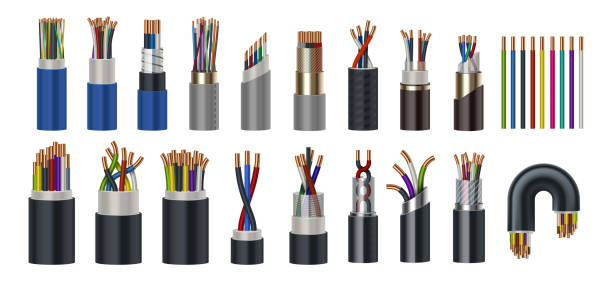Structure and types of low-current cables and stages of cable laying
Today, there are a large number of varieties of low-current cable. This is explained by a wide range of tasks that can be solved using cable networks.
Low-current cables include television cables, computer networks, telephone lines, etc., while power cables are responsible for powering household and lighting devices.
The structure of the cable and wire used to install low-current networks is significantly different from power wires. One of the differences is in the small cross-section of the current conduction of the wires.
What belongs to low current systems?
- trunk and distribution cable network;
- LAN (local computing network);
- satellite television reception and distribution systems;
- Internet and telephone access system;
- SCS (structured cable networks).

How to choose a low current cable?
Depending on what exactly you plan to connect with the low current cable, there are different types of low current cables to choose from.
To connect cable TV with a satellite dish, it is best to use a coaxial cable with a single central core and a metal shield. Its wave resistance should be at least 75 ohms. Between the core and the shield of the coaxial cable there is a dielectric shell, which greatly affects the improvement of the quality of the received television signal.
A two-wire cable with a small cross-section is suitable for ensuring good telephone communication. To mount an open telephone network, you should use copper wire of the TRP brand. This is a flat cable that bends well. Due to these characteristics, it can be laid in any place: even under the plaster, even above it.
As for connecting to the Internet using a low-voltage cable, in this case, an eight-wire “twisted pair” cable can be used. It is quite sensitive to twisting – the data transfer rate in this case is significantly reduced. Also, “twisted pair” has a length limit. A cable longer than 100 m is unsuitable for signal transmission.
Stages of cable laying
The objects of SCM laying can be diverse: today a system of advanced communication lines is needed by educational and medical institutions, private houses and administrative buildings. Of course, each of these cases has its own peculiarities, subtleties, and nuances, but at the same time, cable networks are always laid in several general stages – let’s consider them.
Design and approval works
TK is drawn up and approved, SCM topology is developed and its structure is determined, key decisions are made. At this stage, it is important to take into account the specific and characteristic features of the object: for example, in social and entertainment institutions, open installation is extremely undesirable, while in commercial premises it is quite appropriate and even rational. Naturally, at the same stage, it is important to take into account the wishes of the customer (of course, those that are advisable to implement), so that the cable network meets his expectations.
Cable installation
The implementation of the developed project begins with the installation of specific routes, ports, channels. Professional crews lay planned communication lines, connect telephones, PCs and office equipment, video cameras and surveillance systems to them. In modern conditions, this stage should take place in the shortest possible time, but without losing the quality of installation and without violating the conditions of normal operation of the service facility (if the latter works during the installation of SCM elements).
Start-up and debugging stage
It is checked how well the cable network works, whether there are no breaks in the lines, whether all the necessary equipment is connected. At this stage, it is also determined whether the SCM can withstand the planned loads, whether it is able to work reliably in the peak period, whether it will withstand the influence of attackers’ attacks. The complexity of the inspection may also depend on the wishes of the customer – this issue should be discussed at the design and approval stage.

Scheduled maintenance
All cable networks, even perfectly designed and laid, in the course of their operation are exposed to negative influences and sooner or later their elements fail. Therefore, professionals face the task of minimizing the risk of failure of individual SCM nodes: for this purpose, regular prevention is carried out. Also, at the maintenance stage, replacement of failed elements is performed, and promptly and without stopping the network (for this, the possibility of redundancy must be considered during design).
If each of these stages is implemented at a high level and the principles of SCM construction are followed, the customer will receive a truly modern and reliable network.
